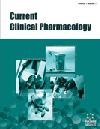- Home
- A-Z Publications
- Current Clinical Pharmacology
- Previous Issues
- Volume 7, Issue 3, 2012
Current Clinical Pharmacology - Volume 7, Issue 3, 2012
Volume 7, Issue 3, 2012
-
-
Novel Direct Factor IIa and Xa Inhibitors: Mechanisms of Action and Preclinical Studies
More LessThe need to overcome certain limitations of the existing anticoagulant agents (heparin, LMWH and VKAs) and to achieve more convenient long-term anticoagulation has fueled the quest for the “ideal anticoagulant”, an agent that would exert at least similar antithrombotic effects with a substantially improved pharmacologic profile and significantly less bleeding complications. The major disadvantages of the traditional ag Read More
-
-
-
Oral IIa and Xa Inhibitors for Prevention of Stroke in Atrial Fibrillation: Clinical Studies and Regulatory Considerations
More LessAtrial fibrillation (AF), the most common, clinically significant, cardiac arrhythmia affects 1% of the general population and has important hemodynamic and thromboembolic complications that contribute to elevated morbidity and mortality. AF increases the overall risk of stroke five-fold, accounting for approximately 15% of all strokes and is associated with particularly severe stroke. For the last 50 years, long-term a Read More
-
-
-
Prevention and Treatment of Venous Thromboembolism and Pulmonary Embolism: The Role of Novel Oral Anticoagulants
More LessVenous thromboembolism, encompassing deep vein thrombosis and pulmonary embolism, is the third most common cause of vascular death after myocardial infarction and stroke. Clinicians are often summoned to make challenging decisions for the prevention and treatment of high risk patients with an unpredicted outcome, often relying on data that are less than definitive. During the last decades, heparins (unfractionat Read More
-
-
-
Novel Oral Anticoagulants in the Treatment of Acute Coronary Syndromes: Is there any Room for New Anticoagulants?
More LessThrombosis plays a key role in the pathophysiology of acute coronary syndromes (ACS). The management of patients with ACS includes interventional procedures and use of antithrombotic agents acutely, and dual antiplatelet therapy (aspirin and a P2Y12 receptor antagonist) for secondary prevention. However, patients with recent ACS remain at a substantial residual risk for recurrent ischemic events or death. T Read More
-
-
-
An Aggressive Medical Approach for Inflammatory Bowel Disease: Clinical Challenges and Therapeutic Profiles in a Retrospective Hospital-based Series
More LessAuthors: Giovanni C. Actis, Floriano Rosina, Rinaldo Pellicano and Mario RizzettoBackground: We studied the toxicity of cyclosporin (CsA), azathioprine, and mesalamine in 94 patients with inflammatory bowel disease (IBD). Methods: 63 treatments with CsA (2mg/kg intravenously or 5 mg/kg orally); 57 with azathioprine (2 mg/kg); and 44 with mesalamine (3.2-4.8 gr) were included. After induction, oral CsA was continued for 6 months, azathioprine for a median of 14 months (range 1-201 mos), mesala Read More
-
-
-
GLP-1 Agonists Exenatide and Liraglutide: A Review About Their Safety and Efficacy
More LessAuthors: Giuseppe Derosa and Pamela MaffioliRecently incretin-based therapies have been developed in the clinical practice, this class includes both the dipeptidyl peptidase-4 (DPP-4) inhibitors (sitagliptin, vildagliptin, saxagliptin, linagliptin), and the glucagon-like peptide- 1 (GLP-1) receptor agonists [exenatide, exenatide long acting release (LAR) and liraglutide]. In particular exenatide and liraglutide have structural similarity and bind to the GLP-1 receptor, displaying a simila Read More
-
-
-
Medical Treatment of Overactive Bladder: An Overview
More LessAuthors: Kanchan Gupta and Sandeep KaushalThe overactive bladder is a common and distressing condition that has a significant impact on the quality of life of millions of people worldwide. Despite its high prevalence, it is a disorder poorly known and not usually tackled in daily clinical practice. The underlying pathophysiology that leads to OAB syndrome is, as yet, incompletely characterized. Non-pharmacological intervention is the foundation of treatment for overactive Read More
-
Volumes & issues
Most Read This Month
Article
content/journals/ccp
Journal
10
5
false
en


